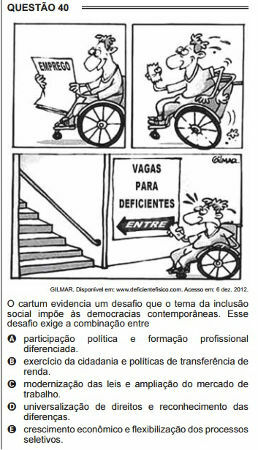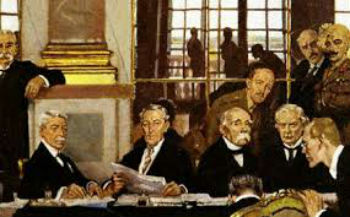In the questions of National High School Exam (And either) relating to the part of SciencesHumanities and their Technologies, which includes subjects like History, geography, Sociology and Philosophy, the visual language is widely explored, that is, there is a wide variety of questions that are formulated from photographs, paintings and drawings by cartoonists. The focus of this text is this last modality: the cartoons.
The Enem and the "competencies"
To understand why Enem attaches great importance to visual language, it is necessary that we know that this exam is guided by the National Curriculum Parameters, as well as by Complementary Educational Guidelines and, in both documents, there is a concern with the “competencies” that students must develop in the learning process. Among these competences is the “mastery of different languages, from languages to mathematical and artistic representations”. This competence, of course, is not dissociated from the other four, which are: "understand processes
, whether social, natural, cultural or technological; diagnose and face real problems, build arguments; and elaborate solidary propositions.”The language of the cartoon
The term "cartoon”, which has several possible meanings, including caricature, comic sketch, etc., appeared in the language English at the turn of the 18th to the 19th century, as well as in France at the same time, under the name of “cartoon”, which means charge (in the sense of concentration of energy). What the cartoon, through drawings and dialogues, always seeks to offer the reader is a shrewd, intelligent, comic and quick reading of everyday events. The cartoon language fits, in the terminology of the PCNs, as “artistic representation”. But, unlike other forms of visual art, cartoons, as they are quite volatile, favor simple lines and framing, trying to do what, in the journalistic world, is called "punch", that is, the “punch”, the impact on the reader.
sample questions
In view of these characteristics, let's go to the examples. Below we offer two questions: the first, question 17 from the blue notebook of the 2014 Enem test, and the second, question 40, also from the blue notebook, but from the 2015 Enem.
Do not stop now... There's more after the advertising ;)
1st question:

Question 17 of ENEM 2014 (blue notebook)
2nd question:

Question 40 of ENEM 2015 (blue notebook)
At firstImage, we see the drawing of a family sitting on a sidewalk. The man, with the text of the 1988 Constitution in hand, she reads an item referring to the fundamental social rights of Brazilian citizens: “Every Brazilian has the right to housing”. The woman, with a child in her arms, replies: “Now read that beautiful piece that talks about food, health...”. This cartoon criticizes the discrepancy between what the Constitutional Charter provides and the reality of many families in the country, who did not have and still do not have housing, or access to food, etc. It is necessary to be aware of the message the cartoonist wants to convey. The only alternative that points to this reading is the B.
already the MondayImage brings three comics in a row. In the first, a person in a wheelchair observes job offers in a newspaper. In the second, he hurries off to go somewhere. In the third, he arrives at the entrance of a place that offers spaces for the disabled, but is frustrated when he sees that access to the place is via a staircase. The irony of the cartoon, in this case, lies in the fact that the job offer aimed at contemplating the group of disabled people is discriminatory. The question header requires the student to point out the challenge that the theme of the social inclusion it imposes on contemporary democracies. The correct alternative is the D, which points to the universalization of rights and the recognition of differences.
By Me. Cláudio Fernandes



